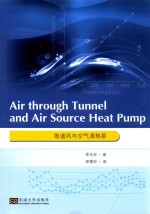

地道风与空气源热泵研究PDF电子书下载
- 电子书积分:9 积分如何计算积分?
- 作 者:李永安著;邢德安译
- 出 版 社:南京:东南大学出版社
- 出版年份:2015
- ISBN:9787564157142
- 页数:191 页
Chapter 1 Introduction 1
1.1 Current situation of energy source in China 1
1.2 Utilization of renewable energy resource 4
1.3 Traditional utility pattern of air through tunnel(hereafter referred to as“ATT”) 6
Chapter 2 Characteristic of Formation Temperature Change 9
2.1 Source of formation energy 9
2.1.1 Solar radiation energy 9
2.1.2 Biological heat 10
2.1.3 Geothermal resources 10
2.2 Thermo-physical property of formation soil 10
2.2.1 Heat conductivity coefficient λ 10
2.2.2 Specific heat cp 11
2.2.3 Thermal diffusivity α 11
2.3 Change rules of soil temperature inside formation 13
2.4 Numerical mathematical model for original soil temperature field 13
2.4.1 Dynamic model of shallow underground soil temperature distribution 14
2.4.2 Solve the shallow formation soil temperature distribution in application of Fourier Law 16
2.5 Characteristic analysis of formation temperature wave 18
2.5.1 Formation soil temperature attenuating property 18
2.5.2 Temperature wave delay 20
2.5.3 Calculation of original formation soil temperature at the same time 21
Chapter 3 Heat Transfer between Soil and Air in Tunnel 23
3.1 Analysis of tunnel wall heat conduction process 23
3.2 Introduction of coupling problem 25
3.3 Selection of turbulence model 29
3.4 Processing of near-wall region 30
3.5 Mathematical description of the model 31
3.6 Mesh generation of mathematical model 32
3.7 Definition of boundary conditions in GAMBIT and FLUENT 33
3.7.1 Settings for boundary conditions 33
3.7.2 Preliminary defining of the types of boundary conditions in the GAMBIT 36
3.7.3 Further defining the conditions of the mathematical model in FLUENT 36
Chapter 4 Process Analysis of Air through Tunnel in Summer 40
4.1 Determination of different parameters in simulation computation 40
4.1.1 Air outdoor meteorological parameters 40
4.1.2 Formation temperature 41
4.1.3 Tunnel masonry material 43
4.1.4 Convection heat transfer coefficient 43
4.2 Analog computation and analysis of all factors for air cooling through tunnel 44
4.2.1 Simulation computation and analysis for air cooling factors through tunnel under 44
4.2.2 Dynamic simulation computation and analysis of air temperature drop through tunnel 52
4.3 Tunnel cooling efficiency 66
4.3.1 Effect of tunnel length on tunnel cooling efficiency 67
4.3.2 Effect of tunnel buried depth on tunnel cooling efficiency 68
4.3.3 Effect of tunnel wind speed on tunnel cooling efficiency 70
4.3.4 Effect of tunnel structure size on tunnel cooling efficiency 71
4.3.5 Effect of different ventilation time on tunnel cooling efficiency 72
Chapter 5 State Change of Air through Tunnel in Winter 75
5.1 Introduction of mathematical model 75
5.1.1 Model zone setting 76
5.1.2 Air outdoor meteorological parameters 76
5.1.3 Formation temperature 78
5.1.4 Soil physical property parameters 79
5.1.5 Determination of convection heat transfer coefficient 80
5.2 Simulation results 81
5.3 Analog computation and analysis of all factors for air heating through tunnel 84
5.3.1 Simulation computation and analysis for air heating factors through tunnel under steady state 84
5.3.2 Dynamic simulation computation and analysis of air temperature drop through tunnel 94
5.4 Tunnel heating efficiency 105
5.4.1 Effect of tunnel length on tunnel heating efficiency 106
5.4.2 Effect of tunnel buried depth on tunnel heating efficiency 108
5.4.3 Effect of tunnel wind speed on tunnel heating efficiency 109
5.4.4 Effect of tunnel structure size on heating efficiency 110
Chapter 6 Air through Tunnel Experimental Study 112
6.1 Experimental object description 112
6.2 Experimental methods and apparatus 114
6.2.1 Conditions preparation before the experiment 114
6.2.2 Experimental methods and procedures 114
6.2.3 Experimental apparatus 116
6.3 Experimental error analysis 118
6.3.1 Experimental apparatus error analysis 119
6.3.2 Error analysis of experimental measurement 119
6.4 Experimental procedures and data processing 121
6.4.1 The experimental procedures and results of tunnel parameters measurement under original state 121
6.4.2 Experimental procedures and results of each measured parameters inside the tunnel under ventilation state 125
6.5 Comparative analysis of experimental results and theoretical calculation 131
Chapter 7 ASHP 136
7.1 Heat pump and its type 136
7.2 Air source heat pump(ASHP) 137
7.3 The characteristics of ASHP 140
7.4 The applicability of ASHP 143
Chapter 8 Air Source Heat Pump Based on Air through Tunnel 150
8.1 Air source heat pump based on air through tunnel 150
8.2 Introduction of ASHP experimental system based on air through tunnel 152
8.2.1 Work principle of ASHP system based on ATT 152
8.2.2 Experiment facility and test method 153
8.3 Experiment data and analysis of ASHP based on ATT 157
8.4 Frostless ASHP based on ATT 162
8.5 Application analysis of ASHP based on ATT 164
8.6 Innovation analysis of ASHP based on ATT 168
Annex 173
Annex 1 Surface Temperature,Temperature Wave Amplitude,and Maximum Depth of Frozen Ground of Main Cities in China 173
Annex 2 Calculating Parameter for Building Material Thermo Physical Characteristic 181
- 《红色旅游的社会效应研究》吴春焕著 2019
- 《汉语词汇知识与习得研究》邢红兵主编 2019
- 《生物质甘油共气化制氢基础研究》赵丽霞 2019
- 《东北民歌文化研究及艺术探析》(中国)杨清波 2019
- 《联吡啶基钌光敏染料的结构与性能的理论研究》李明霞 2019
- 《异质性条件下技术创新最优市场结构研究 以中国高技术产业为例》千慧雄 2019
- 《《国语》和《战国策》词汇比较研究》陈长书著 2017
- 《中国制造业绿色供应链发展研究报告》中国电子信息产业发展研究院 2019
- 《行政保留研究》门中敬著 2019
- 《新课标背景下英语教学理论与教学活动研究》应丽君 2018
- 《中风偏瘫 脑萎缩 痴呆 最新治疗原则与方法》孙作东著 2004
- 《水面舰艇编队作战运筹分析》谭安胜著 2009
- 《王蒙文集 新版 35 评点《红楼梦》 上》王蒙著 2020
- 《TED说话的力量 世界优秀演讲者的口才秘诀》(坦桑)阿卡什·P.卡里亚著 2019
- 《燕堂夜话》蒋忠和著 2019
- 《经久》静水边著 2019
- 《魔法销售台词》(美)埃尔默·惠勒著 2019
- 《微表情密码》(波)卡西亚·韦佐夫斯基,(波)帕特里克·韦佐夫斯基著 2019
- 《看书琐记与作文秘诀》鲁迅著 2019
- 《酒国》莫言著 2019
